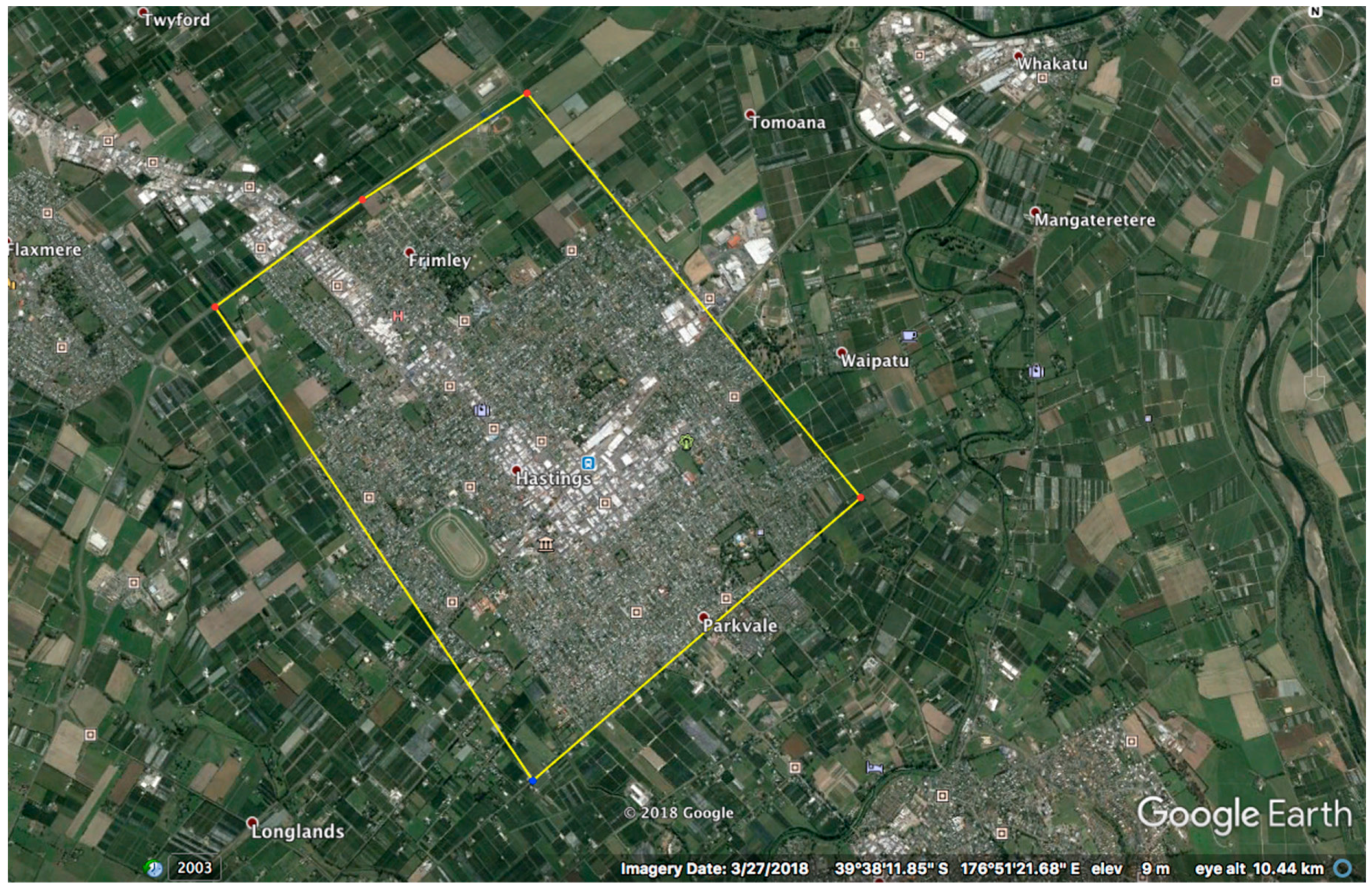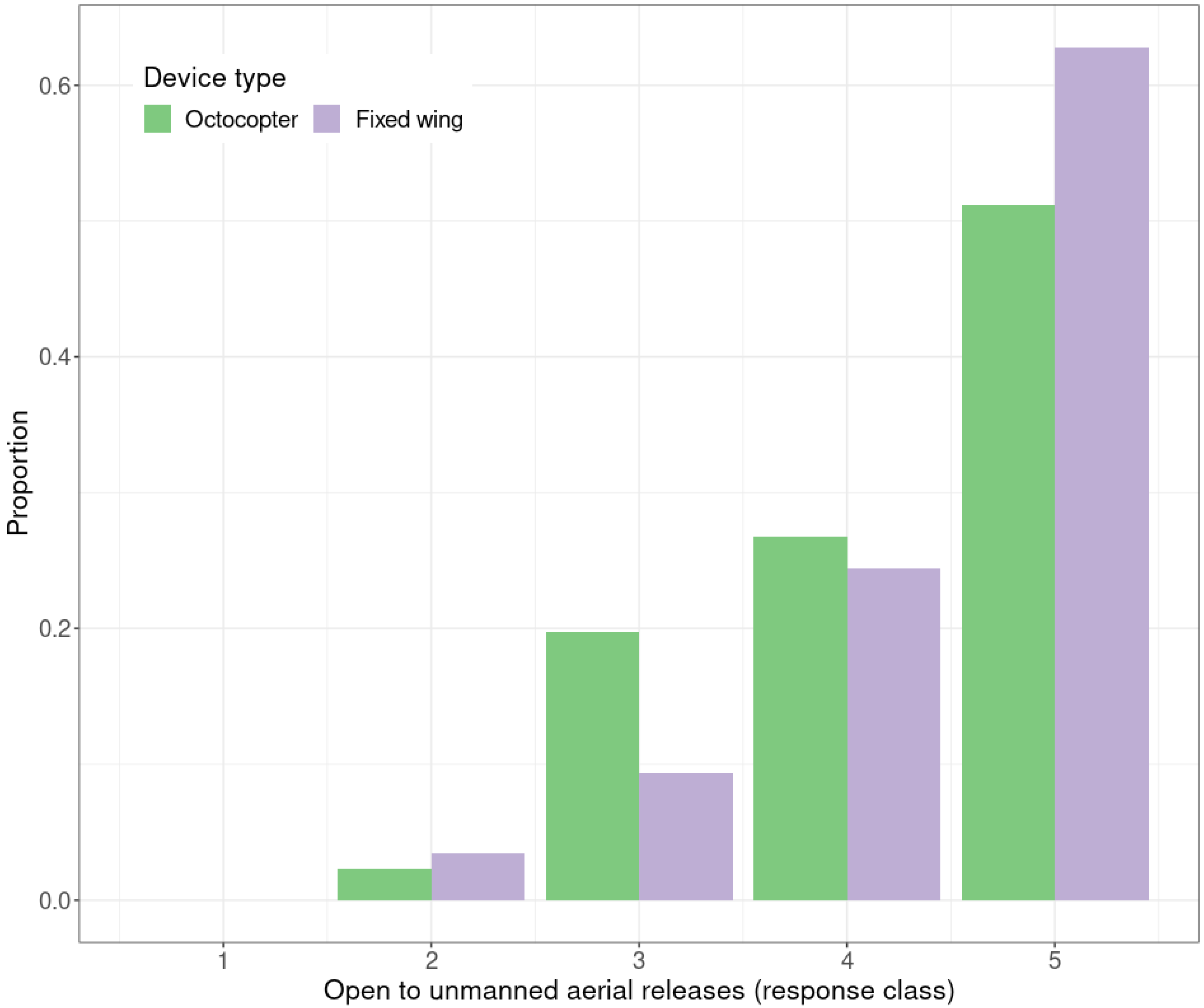Peri-Urban Community Attitudes towards Codling Moth Trapping and Suppression Using the Sterile Insect Technique in New Zealand
Abstract
:1. Introduction
2. Methods
2.1. Ethic
2.2. Selection of Sample Size
2.3. Selected Study Site
2.4. Questionnaire
2.5. Data Analysis
3. Results
3.1. Age and Gender
3.2. Concern about Invasive Species
3.3. Family in Horticulture
3.4. Pheromone Traps and Host Trees
3.5. Response to Unmanned Aerial Vehicles
3.6. General Community Response
4. Discussion
4.1. Community Attitudes
4.2. Community Perceptions of Spraying
5. Conclusions
Supplementary Materials
Author Contributions
Funding
Acknowledgments
Conflicts of Interest
References
- Banks, N.C.; Paini, D.R.; Bayliss, K.L.; Hodda, M. The role of global trade and transport network topology in the human-mediated dispersal of alien species. Ecol. Lett. 2015, 18, 188–199. [Google Scholar] [CrossRef] [PubMed]
- Levine, J.M.; D’Antonio, C.M. Forecasting biological invasions with increasing international trade. Conserv. Biol. 2003, 17, 322–326. [Google Scholar] [CrossRef]
- Tobin, P.C.; Kean, J.M.; Suckling, D.M.; McCullough, D.G.; Herms, D.A.; Stringer, L.D. Determinants of successful arthropod eradication programs. Biol. Invasions 2014, 16, 410–414. [Google Scholar] [CrossRef]
- Liebhold, A.M.; Berec, L.; Brockerhoff, E.G.; Epanchin-Niell, R.S.; Hastings, A.; Herms, D.A.; Kean, J.M.; McCullough, D.G.; Suckling, D.M.; Tobin, P.C.; et al. Eradication of invading insect populations: From concepts to applications. Annu. Rev. Entomol. 2016, 61, 335–352. [Google Scholar] [CrossRef] [PubMed]
- Lopez-Vaamonde, C.; Agassiz, D.; Augustin, S.; De Prins, J.; De Prins, W.; Gomboc, S.; Ivinskis, P.; Karsholt, O.; Koutroumpas, A.; Koutroumpa, F.; et al. Lepidoptera: Chapter 11. BioRisk 2010, 4, 603–668. [Google Scholar] [CrossRef]
- Pimentel, D.; McNair, S.; Janecka, J.; Wightman, J.; Simmonds, C.; O’Connell, C.; Wong, E.; Russel, L.; Zern, J.; Aquino, T.; et al. Economic and environmental threats of alien plant, animal, and microbe invasions. Agric. Ecosyst. Environ. 2001, 84, 1–20. [Google Scholar] [CrossRef]
- Aukema, J.E.; Leung, B.; Kovacs, K.; Chivers, C.; Britton, K.O.; Englin, J.; Frankel, S.J.; Haight, R.G.; Holmes, T.P.; Liebhold, A.M.; et al. Economic impacts of non-native forest insects in the continental United States. PLoS ONE 2011, 6, e24587. [Google Scholar] [CrossRef]
- Genovesi, P. Are we turning the tide? Eradications in times of crisis: How the global community is responding to biological invasions. In Turning the Tide: The Eradication of Invasive Species, Proceedings of the International Conference on Island Invasives; Veitch, C.R., Clout, M.N., Towns, D.R., Eds.; IUCN: Gland, Switzerland; Auckland, New Zealand, 2011; pp. 1–8. [Google Scholar]
- Lester, P.J.; Beggs, J.R. Invasion success and management strategies for social Vespula wasps. Annu. Rev. Entomol. 2019, 64, 51–71. [Google Scholar] [CrossRef]
- Stephens, A.E.A.; Stringer, L.D.; Suckling, D.M. Advance, retreat, resettle? Climate change could produce a zero-sum game for invasive species. Austral Entomol. 2016, 55, 177–184. [Google Scholar] [CrossRef]
- Suckling, D.M.; Stringer, L.D.; Baird, D.B.; Kean, J.M. Will growing invasive arthropod biodiversity outpace our ability for eradication? Ecol. Appl. 2019. [Google Scholar] [CrossRef]
- Walker, J.T.; Suckling, D.M.; Wearing, C.H. Past, present, and future of integrated control of apple pests: The New Zealand experience. Annu. Rev. Entomol. 2017, 62, 231–248. [Google Scholar] [CrossRef] [PubMed]
- Leskey, T.C.; Short, B.D.; Butler, B.R.; Wright, S.E. Impact of the invasive brown marmorated stink bug, Halyomorpha halys (Stål), in Mid-Atlantic tree fruit orchards in the United States: Case studies of commercial management. Psyche 2012, 2012. [Google Scholar] [CrossRef]
- Mankad, A.; Loechel, B.; Measham, P.F. Psychosocial barriers and facilitators for area-wide management of fruit fly in southeastern Australia. Agron. Sustain. Dev. 2017, 37, 67. [Google Scholar] [CrossRef] [Green Version]
- Suckling, D.M.; Conlong, D.E.; Carpenter, J.E.; Bloem, K.A.; Rendon, P.; Vreysen, M.J.B. Global range expansion of pest Lepidoptera requires socially acceptable solutions. Biol. Invasions 2016, 19, 1107–1119. [Google Scholar] [CrossRef] [Green Version]
- Suckling, D.M.; Tobin, P.C.; McCullough, D.G.; Herms, D.A. Combining tactics to exploit Allee effects for eradication of alien insect populations. J. Econ. Entomol. 2012, 105, 1–13. [Google Scholar] [CrossRef] [PubMed]
- Barclay, H.J. Models for pest control: Complementary effects of periodic releases of sterile pests and parasitoids. Theor. Popul. Biol. 1987, 32, 76–89. [Google Scholar] [CrossRef]
- Knipling, E.F. The Basic Principles of Insect Population Suppression and Management; US Department of Agriculture (USDA, SEA): Washington, DC, USA, 1979; p. 659.
- Tapsuwan, S.; Capon, T.; Tam, M.; Kandulu, J.; Measham, P.; Whitten, S. Willingness to pay for area-wide management and sterile insect technique to control fruit flies in Australia. Int. J. Pest. Manag. 2019, 1–17. [Google Scholar] [CrossRef]
- Vreysen, M.J.B.; Carpenter, J.E.; Marec, F. Improvement of the sterile insect technique for codling moth Cydia pomonella (Linnaeus) (Lepidoptera Tortricidae) to facilitate expansion of field application. J. Appl. Entomol. 2010, 134, 165–181. [Google Scholar] [CrossRef]
- Horner, R.M.; Walker, J.T.S.; Rogers, D.J.; Lo, P.L.; Suckling, D.M. Use of the sterile insect technique in New Zealand: Benefits and constraints. N. Z. Plant Prot. 2016, 69, 296–304. [Google Scholar]
- Wearing, H. Farewell Silent Spring: The New Zealand Apple Story; The New Zealand Plant Protection Society: Auckland, New Zealand, 2019; p. 278. [Google Scholar]
- Proverbs, M.D.; Newton, J.R.; Logan, D.M. Suppression of codling moth, Laspeyresia pomonella (Lepidoptera: Olethreutidae), by release of sterile and partially sterile moths. Can. Entomol. 1978, 110, 1095–1102. [Google Scholar] [CrossRef]
- Bloem, K.A.; Bloem, S.; Carpenter, J.E. Impact of moth suppression/eradication programmes using the sterile insect technique or inherited sterility. In Sterile Insect Technique: Principles and Practice in Area-Wide Integrated Pest Management; Dyck, V.A., Hendrichs, J., Robinson, A.S., Eds.; Springer: Dordrecht, The Netherlands, 2005; pp. 677–700. [Google Scholar]
- Suckling, D.M.; Charles, J.; Allan, D.; Chaggan, A.; Barrington, A.; Burnip, G.M.; El-Sayed, A.M. Performance of irradiated Teia anartoides (Lepidoptera: Lymantriidae) in urban Auckland, New Zealand. J. Econ. Entomol. 2005, 98, 1531–1538. [Google Scholar] [CrossRef] [PubMed]
- Suckling, D.M.; Stringer, L.D.; Baird, D.B.; Butler, R.C.; Sullivan, T.E.S.; Lance, D.R.; Simmons, G.S. Light brown apple moth (Epiphyas postvittana)(Lepidoptera: Tortricidae) colonization of California. Biol. Invasions 2014, 16, 1851–1864. [Google Scholar] [CrossRef]
- Brockerhoff, E.B.; Liebhold, A.; Richardson, B.; Suckling, D.M. Eradication of invasive forest insects: Concept, methods, costs and benefits. N. Z. J. For. Sci. 2010, 40, S117–S135. [Google Scholar]
- Gamble, J.C.; Payne, T.; Small, B. Interviews with New Zealand community stakeholders regarding acceptability of current or potential pest eradication technologies. N. Z. J. Crop Hortic. Sci. 2010, 38, 57–68. [Google Scholar] [CrossRef]
- Mankad, A. Psychological influences on biosecurity control and farmer decision-making. A review. Agron. Sustain. Dev. 2016, 36, 40. [Google Scholar] [CrossRef]
- Heger, T.; Pahl, A.T.; Botta-Dukat, Z.; Gherardi, F.; Hoppe, C.; Hoste, I.; Jax, K.; Lindstrom, L.; Boets, P.; Haider, S.; et al. Conceptual frameworks and methods for advancing invasion ecology. Ambio 2013, 42, 527–540. [Google Scholar] [CrossRef] [PubMed]
- Crowley, S.L.; Hinchliffe, S.; McDonald, R.A. Conflict in invasive species management. Front. Ecol. Environ. 2017, 15, 133–141. [Google Scholar] [CrossRef] [Green Version]
- Montreal Protocol. Available online: http://ozone.unep.org/new_site/en/montreal_protocol.php (accessed on 25 September 2019).
- Greer, G. The Potential Economic Impact of Codling Moth Control Using the Sterile Insect Technique; Internal Report for The New Zealand Institute for Plant and Food Research Ltd.; The New Zealand Institute for Plant and Food Research Ltd.: Auckland, New Zealand, 2018. [Google Scholar]
- StatsNZ. Statistics New Zealand, Census QuickStats about a place: Hawke’s Bay Region. Available online: http://archive.stats.govt.nz/Census/2013-census/profile-and-summary-reports/quickstats-about-a-place.aspx?request_value=14018&tabname=# (accessed on 22 March 2018).
- Bartlett, J.E.; Kotrlik, J.W.; Higgins, C.C. Organizational research: Determining appropriate sample size in survey research. Inf. Technol. Learn. Perform. J. 2001, 19, 43–50. [Google Scholar]
- Krejcie, R.V.; Morgan, D.W. Determining sample size for research activities. Educ. Psychol. Meas. 1970, 30, 607–610. [Google Scholar] [CrossRef]
- Russell, J.C.; Innes, J.G.; Brown, P.H.; Byrom, A.E. Predator-Free New Zealand: Conservation Country. Bioscience 2015, 65, 520–525. [Google Scholar] [CrossRef] [Green Version]
- Green, W.; Rohan, M. Opposition to aerial 1080 poisoning for control of invasive mammals in New Zealand: Risk perceptions and agency responses. J. R. Soc. N. Z. 2012, 42, 185–213. [Google Scholar] [CrossRef]
- Mercier, O.R.; King Hunt, A.; Lester, P. Novel biotechnologies for eradicating wasps: Seeking Māori studies students’ perspectives with Q method. Kōtuitui N. Z. J. Soc. Sci. Online 2019, 14, 136–156. [Google Scholar] [CrossRef]
- Smith, M. Report of the Opinion of Ombudsman Mel Smith on Complaints Arising from Aerial Spraying of the Biological Insecticide Foray 48B on the Population of Parts of Auckland and Hamilton to Destroy Incursions of Painted Apple Moths, and Asian Gypsy Moths, Respectively During 2002-2004. Office of the Ombudsmen. Available online: http://www.ombudsman.parliament.nz/system/paperclip/document_files/document_files/302/original/own_motion_aerial_spraying.pdf?1344401747 (accessed on 13 March 2017).
- HBRC. Agrichemical Use, Hawke’s Bay Regional Council. Available online: https://www.hbrc.govt.nz/hawkes-bay/air-quality/agrichemical-use/ (accessed on 31 April 2018).





| Questions Raised |
| “Will there be cameras attached to these things? Will they be able to see me?” “Do they have cameras on them?” “Will this affect any other insects like butterflies?” “How many moths will get released and how often?” “Will this affect bee populations at all?” “Will this be bad for my children?” “Are there cameras attached?” “I don’t think this is important. What’s on my property?” “They aren’t toxic right? They can’t affect my toddler or cat?” “How do they know where to release?” “Do they have cameras?” “Will this affect my children? Is it toxic at all?” “How will this affect my cat? Will they bother him?” “Are there cameras on them? Will they record?” “Will this affect what’s in my garden?” |
© 2019 by the authors. Licensee MDPI, Basel, Switzerland. This article is an open access article distributed under the terms and conditions of the Creative Commons Attribution (CC BY) license (http://creativecommons.org/licenses/by/4.0/).
Share and Cite
Paterson, G.; Perry, G.L.W.; Walker, J.T.S.; Suckling, D.M. Peri-Urban Community Attitudes towards Codling Moth Trapping and Suppression Using the Sterile Insect Technique in New Zealand. Insects 2019, 10, 335. https://doi.org/10.3390/insects10100335
Paterson G, Perry GLW, Walker JTS, Suckling DM. Peri-Urban Community Attitudes towards Codling Moth Trapping and Suppression Using the Sterile Insect Technique in New Zealand. Insects. 2019; 10(10):335. https://doi.org/10.3390/insects10100335
Chicago/Turabian StylePaterson, Georgia, George L. W. Perry, James T. S. Walker, and David Maxwell Suckling. 2019. "Peri-Urban Community Attitudes towards Codling Moth Trapping and Suppression Using the Sterile Insect Technique in New Zealand" Insects 10, no. 10: 335. https://doi.org/10.3390/insects10100335





